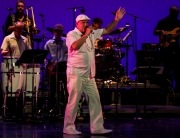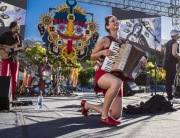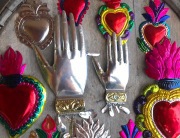The World’s Largest Folk Art Festival Celebrates 15 Years
Featuring more than 150 Master Artists from 50 Countries and
Nobel Peace Prize-Winner Dr. Muhammad Yunus as Honorary Chair
July 13, 14 and 15, 2018—Museum Hill in Santa Fe, New Mexico

Santa Fe, New Mexico—In July 2004, 61 master folk artists from 36 countries ventured to this high-desert city to share in a then untested proposition that creativity, prosperity and community wellbeing could be realized through the art of the handmade.
This July, that proposition—the Santa Fe International Folk Art Market—marks 15 years of art and impact as 150 folk artists from 50 countries gather at the world’s largest, most diverse folk art festival to celebrate cherished craft traditions and contribute to global unity and economic change.
The 2018 Market is an event the world’s art and culture lovers won’t want to miss as 34 first-time artists join 116 returning artists, and two countries never before represented at the Market—Azerbaijan and Greece—step onto the global folk art stage. Twenty-eight artists will again provide Innovation Inspiration in a special exhibition area, translating traditional folk art materials and techniques into works of modern meaning.
Collectively, these creators’ eye-dazzling forms, textures and designs—textiles, jewelry, beadwork, basketry, sculpture, ceramics, rugs, metal work, clothing, home accessories and more—blur borders in colorful displays of cultural dignity, beauty and hope.
Serving as Honorary Market Chair on this 15th anniversary milestone is Dr. Muhammad Yunus, winner of the 2006 Nobel Peace Prize. As a leader and believer in creating economic change for impoverished communities through social innovation and entrepreneurship, Yunus’ participation pays tribute to the Market’s influence and impact as a global change maker.
ART + IMPACT
The interactions we have are what make the Market so special. Learning and helping each other is the best way for the industry to grow and to make an ever greater positive impact for all artisans everywhere.
— Zoe Davidson, Tintsaba, Swaziland
Since 2004, the Market has shaped an extraordinary story of art and impact. Highlights include:
- Hosting nearly 1,000 master folk artists from 98 countries
- Generating $28 million from artist sales—90% of which goes home with first-time artists
- Impacting over 1.2 million lives worldwide
- Drawing 233,000 Market attendees—with an estimated economic impact of $142 million
Even as the numbers continue to change, the Market’s belief in the power of folk artists as cultural ambassadors whose creations provide common ground in an increasingly polarized world remains the same. From the Market’s inception, the world has also believed—sparking an international folk art movement in Santa Fe that today resonates throughout the global creative economy as consumers and retailers embrace the handmade and support the artisan sector.
Perhaps the biggest believers are Market artists. They attend the Market individually or as representatives of family enterprises and community cooperatives, and many come from developing countries where the daily income averages less than $3.10 a day. For them, three days in Santa Fe both affirms the value of their artistry and affords vital resources for education, infrastructure and medicine for their families and communities. It provides the means to help fight political dislocation, gender inequity, and other forms of social and economic oppression.
They are artists such as metalworker Serge Jolimeau of Haiti, who has attended the Market every year since 2004. Jolimeau translates his Market successes into training and employment opportunities for young Haitians, who are perpetuating Haiti’s unique art of recycled oil drum sculpture and helping to strengthen their fragile economy.
Peruvian weaver Nilda Callañaupa Álvarez has built a robust network of indigenous weavers in Peru who have revitalized ancient handmade Andean weaving techniques and designs that were nearly lost to modern mechanization and political instability. In Peru and internationally, Callañaupa’s Centro de Textiles Tradicionales de Cusco is a model of entrepreneurship and a respected voice for women’s empowerment.
The economic power of women weavers also resonates in villages throughout Laos, where the Ock Pop Tok women’s weaving enterprise has transformed a small shop selling a few designs to one of the most important textile and artisan institutions in Laos and Southeast Asia. Their pioneering business practices provide sustainable livelihoods for women weavers and educational eco-tourism experiences for visitors from around the globe.
Meanwhile, in a small village in Oaxaca, Mexico, weaver Porfirio Gutiérrez revived his community’s esteemed tradition of natural dyes to both illuminate the vibrant beauty of Zapotec textiles and eliminate the health and environmental hazards created by the use of toxic artificial dyes. His emphasis on preservation and education has created new artistic and economic opportunities for weavers and dye-related enterprises throughout Mexico.
The blessings of nature also provide inspiration for India’s Adiv Pure Nature textile dye enterprise, which was represented at the Market for the first time in 2017. Founder Rupa Trivedi’s innovative Temple Blessings Project recycles flowers, plants and other offerings from sacred temples into dyes and materials for delicately textured silk and cotton textiles. The project provides critical training and employment opportunities for women, elders and homeless youth from throughout urban Mumbai.
For these and other Market artists, Santa Fe has become a destination for global connection and artistic excellence. For the some 20,000 annual Market attendees, the experience of encountering artists and art from worlds away offers powerful and positive lessons in the value of multicultural, person-to-person exchange. As Mrs. Panee Khounviley of Ock Pop Tok describes her 2017 experience in Santa Fe:
“I loved being an ambassador for Lao and sharing my culture and textiles with people from around the world. I realized that I am a part of a bigger community of folk artists around the world.”
FOLK ART FOR THE FUTURE
“This is the world’s best market. It changes lives, preserves traditional craft, and leads us forward with innovative ideas.”
—Abduljabbar Khatri, Sidr Craft, 2017 Living Tradition Award Recipient
While the Market is rooted in a reverence for tradition, it has also been a pioneer in supporting artists to move their traditions forward in culturally and economically sustainable ways. Juried by two panels of experts, the Market is carefully curated to represent the highest quality folk art made in the world—and for the world—today.
Back by popular demand at the 2018 Market after its successful debut last year is Innovation Inspiration. This Market initiative celebrates and encourages artists who are infusing their communities’ folk art traditions with personal expression, fresh perspectives and bold experimentation. In 2018, this special exhibition area features 28 artists whose works span the categories of Social Commentary, Design, and Re-use and Recycle.
Meanwhile, the Market’s long-running Mentor to Market program again offers multi-tiered training and education, from basic business and marketing skills, to intensive training partnerships with accomplished business mentors, to hands-on experience in the wholesale marketplace. The Market will also again recognize successful examples of leadership and entrepreneurship with the 2018 Living Tradition and Community Impact awards.
A MODEL OF PARTNERSHIP
Since 2004, the Market’s model of community-based enterprise and collaboration has been bolstered by partnerships worldwide, including such respected global cultural leaders as UNESCO and the World Craft Council.
In 2018, Dr. Muhammad Yunus, winner of the 2006 Nobel Peace Prize, will join the Market family as Honorary Co-Chair. Yunus, a Bangladeshi economist, founded Grameen Bank in 1983 with a philosophy that everyone is a natural entrepreneur. He has since provided more than $26 billion in collateral-free loans to nine million borrowers—more than 97 percent of them women.
In addition to the world’s folk artists, perhaps the most essential partner in the Market’s history has been the city of Santa Fe, a place rich in its own indigenous cultures and craft traditions and a history of cross-cultural exchange and commerce. Santa Fe’s vitality as an arts and culture destination has catalyzed the Market’s extraordinary volunteer base—drawing more than 6,700 volunteers from Santa Fe, throughout New Mexico, and beyond since 2004. In turn, the Santa Fe and statewide economy has benefited from some $2 million in state gross receipts taxes and fees since 2004.
MARKET LOGISTICS
The International Folk Art Market | Santa Fe opens with a party on the evening of Friday, July 13, and runs through Sunday, July 15, 2018, at the beautiful Milner Plaza on Santa Fe’s Museum Hill. Tickets go on sale May 1, 2018. For detailed information and schedule of events, visit 172.97.101.154
International Folk Art Market | Santa Fe is held in partnership with the New Mexico Department of Cultural Affairs, Museum of International Folk Art, Museum of Indian Arts and Culture, Museum of New Mexico Foundation, and the City of Santa Fe.
For more information, interview requests, and photos, please contact Clare Hertel at 505-474-6783 or clare@clarehertelcommunications.com.





